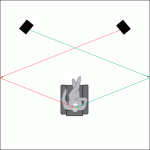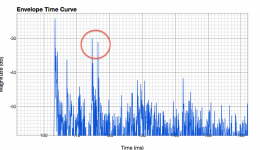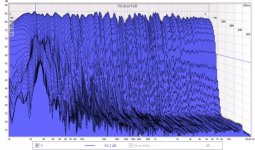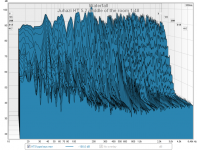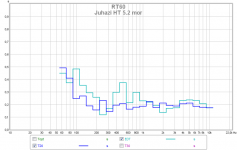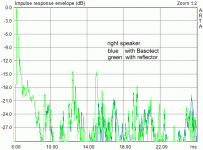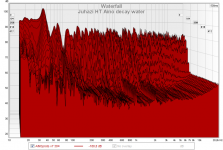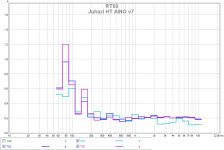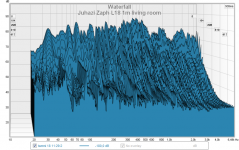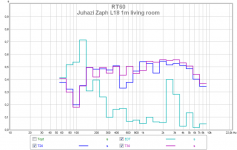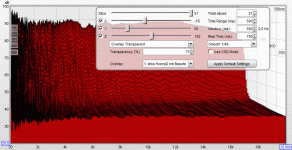Thanks for clarification. But now you've made me curious. With strong front wall reflections, my soundstage moves backwards to the front wall and is glued to that wall with minimal depth.
With attenuated front wall reflections the "distance" of the acoustic scene becomes smaller - moving the front of the AS a bit nearer to the speaker base. The "depth" grows - extending the perceived AS farther into the "next room". This seems to be different (almost contrary) from your experience.
Maybe I'm bad at describing my experience.... but I do experience the same thing as you do.
What I also tried to say is that front wall reflection adds some artificial depth to everything, but the maximum depth that can be achieved with proper recordings is smaller.
Last edited:
Markus,It's not about widening the soundstage but about adding spaciousness. It doesn't make the stage wider, it give the single auditory events a three dimensional quality.
Here's a schematic of the two different panel configurations I tried to describe ...
my configuration for above case looks more like this:
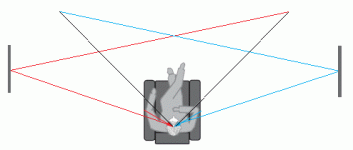
I measured the response (to one side only) with a reflective panel and with 7 cm thick Basotect covering that panel:
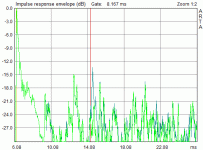
The contralateral reflection is about 8.5 ms late. You can see the difference just right from the red bar. Blue is the reflective case and green is with Basotect. The peak difference is about 9 dB.
Is this along the line you are thinking? If you approve I would look for a panel for the other side and report my findings.
Rudolf
Hi Rudolf,
Looks good but the reflection should probably be louder.
My setup looks something like this (with absorption over the whole front wall and behind the speakers):

This results in two strong contralateral reflections (one is a second order ceiling reflection):

Looks good but the reflection should probably be louder.
My setup looks something like this (with absorption over the whole front wall and behind the speakers):
This results in two strong contralateral reflections (one is a second order ceiling reflection):
Attachments
Last edited:
Hi Markus,Hi Rudolf,
Looks good but the reflection should probably be louder.
I can't get the contralateral reflection louder than -12 dB if I don't want to have it earlier than 8 ms. The difference between full reflection and full absorption is faintly audible in my case - since I know that there has to be a difference
Panels are 0.5-0.7m wide and 1m high. I raised them to center with speaker height.Vary toe-in so more energy gets radiated towards the panel and less to the listening position and/or bring the panel closer to the listening position.
How large is it?
I can't toe-in the dipoles sufficiently - would need nearly 90° toe in, which raises other problems.
There are solutions which work with certain directivities and room proportions, but not universally.
Back to basics,
This is a decay waterfall (and speaker response at listening spot) of a listening room for dipoles by pieskapov, mentioned before here. 1/48 smoothing.
The room is roughly w3xl5xh2,2m and heavily treated acoustically. The main speakers have only passive xo but dipole woofers are eq'd and xo'd with Behringer DCX 2496.
Sound an imaging are super, as good as stereo speakers can be, to my ears. Sidewall, floor and ceiling reflections are minimal. Room has a 27Hz mode but it is rather benign.
Try to beat this!
This is a decay waterfall (and speaker response at listening spot) of a listening room for dipoles by pieskapov, mentioned before here. 1/48 smoothing.
The room is roughly w3xl5xh2,2m and heavily treated acoustically. The main speakers have only passive xo but dipole woofers are eq'd and xo'd with Behringer DCX 2496.
Sound an imaging are super, as good as stereo speakers can be, to my ears. Sidewall, floor and ceiling reflections are minimal. Room has a 27Hz mode but it is rather benign.
Try to beat this!
Attachments
Arta will only do CSD plots with 1/12 oct smoothingThis is a decay waterfall (and speaker response at listening spot) of a listening room for dipoles by pieskapov, mentioned before here. 1/48 smoothing.
You have noted the 500 ms time scale? Under such circumstances my ARTA CSD looks worse (because I look at it from a more elevated perspective), but shows practically the same result.Try to beat this!
Rudolf
This is my HT measured at the midpoint of the room (minimal modes) all 5.2 speakers playing. 25 slices 500ms
This is my best measured room response at home! Rt is 0,2 except <100Hz.
This is my best measured room response at home! Rt is 0,2 except <100Hz.
Attachments
Last edited:
Back to basics,
This is a decay waterfall (and speaker response at listening spot) of a listening room for dipoles by pieskapov, mentioned before here. 1/48 smoothing.
The room is roughly w3xl5xh2,2m and heavily treated acoustically. The main speakers have only passive xo but dipole woofers are eq'd and xo'd with Behringer DCX 2496.
Sound an imaging are super, as good as stereo speakers can be, to my ears. Sidewall, floor and ceiling reflections are minimal. Room has a 27Hz mode but it is rather benign.
Try to beat this!
This is listening position in my totally normal, zero acoustically treated living room of Pluto Clone. Room has lots of glass and brick. No sub, listening position:
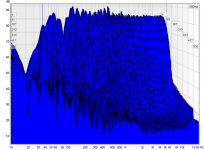
Setup is very unobtrusive.
I'm sure the system your picture references sounds very nice indeed.
But I really doubt that it would get the Markus seal of approval for spaciousness presentation until some detail robbing contralateral reflections are added.
Barlyewater, I think that your room must be quite large? Looking at the very even response orherwise but peak at 80,220and dip at 140
My HT room is small and half-lined with bookselves. My living room is more than 2 times bigger and has many openings and relatively less furniture. It makes it sound different. I suffer from noise of ventilation too.
One remarkable thing of pieskapov's room is the very low level of ambient noise. It is in the basement and he shuts off air ventilation when listening.
My HT room is small and half-lined with bookselves. My living room is more than 2 times bigger and has many openings and relatively less furniture. It makes it sound different. I suffer from noise of ventilation too.
One remarkable thing of pieskapov's room is the very low level of ambient noise. It is in the basement and he shuts off air ventilation when listening.
But I really doubt that it would get the Markus seal of approval for spaciousness presentation until some detail robbing contralateral reflections are added.
Why the sarcasm? I wasn't talking about "some" reflections but very specific ones.
I wouldn't approve because of the missing and uneven low end in your graphs.
Does it really make sense to measure all 5.2 speakers together? What's your thinking behind that?This is my HT measured at the midpoint of the room (minimal modes) all 5.2 speakers playing. 25 slices 500ms
Measurements are always for one speaker only. This is for the opposite side:
There's a slight delay between the two reflections. Did you also try to place the boards behind the listening position?
This is a decay waterfall (and speaker response at listening spot) of a listening room for dipoles by pieskapov, mentioned before here. 1/48 smoothing.
This is my HT measured at the midpoint of the room (minimal modes) all 5.2 speakers playing. 25 slices 500ms
This is listening position in my totally normal, zero acoustically treated living room of Pluto Clone. Room has lots of glass and brick. No sub, listening position:
What's the window time in all those graphs?
Rudolf, 5.2 mesasurement was just easily at hand to show. I have saved lots of measurements made for different purposes. Here are one speaker - measurements from my HT and my living room too. HT measurement has too low level, it was jus a check for xo tuning. Living room measurement were done in 2009 and I haven't measured one speaker there since!
Measuring distance, number of speakers playing and microphone position don't seem to affect decay very much, it measures mostly room conditions. A speaker's amplitude response, phase, distortion, GD etc. measurements are not reliable unless done from one speaker playing and mic position standardized.
Time window for my decay graphs is 500ms and it can be seen on the z axis markings. REW takes 500ms automatically and the user can set time window, limits and smoothing. The decay plots automatically use 500ms.
Measuring distance, number of speakers playing and microphone position don't seem to affect decay very much, it measures mostly room conditions. A speaker's amplitude response, phase, distortion, GD etc. measurements are not reliable unless done from one speaker playing and mic position standardized.
Time window for my decay graphs is 500ms and it can be seen on the z axis markings. REW takes 500ms automatically and the user can set time window, limits and smoothing. The decay plots automatically use 500ms.
Attachments
Markus,
Sorry about the sarcastic jibe. I'll refrain. Too much of this crap litters the forum already.
Waterfall plots must be taken with grain of salt; parameters must be given/chosen in context of measurement. Here I fished around to get similar texture as in Juhazi's plots to illuminate point. My plots used 300ms window.
REW doesn't apply smoothing that is used in SPL plots for waterfall plots, but indeed the size of the sliding window that generates the time slices is manner of smoothing. Perceptually this may be akin to how one senses strong impulsive sound isolated in 500ms.
Shortening the window to 12ms results in very different looking waterfall plot:
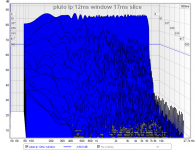
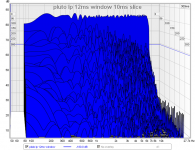
and a 1ms windowed waterfall:
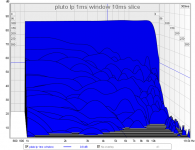
When waterfall window is shorter than time between slices, waterfall plot is perhaps more concise presentation, whereas windows longer than slice interval have blurring/merging effect that presents smoother looking waterfall.
No doubt, heavily treated room is cleaner sound, and indeed likely better for surround setups that provide additional ambiance/spatial information.
IMO, not what I'd be looking for with huge catalog of stereo recordings. Yeah, back channels and digital reverberation can be added, but this leads to potentially fiddling with settings on recording by recording basis. With media server and convolution engine one has potential to tag each reverberation to specific recordings or sets of recordings. This becomes interactive homework, which once done for track(s) that just don't bring it home (or listener to venue/mixing space) works very well for some. A one for all setup just can't exist for the extreme variety of music and recording engineering in stereo catalog.
Flat response is starting point, but point of listening is to bring pleasure. Always compromises.
I would like to see polar performance of Nathans, other than Dr. Geddes own results. Something along lines of stationary microphone at about 1m with speaker rotated about vertical axis through apparent acoustic center of speaker, with focus on bandwidth above 500Hz.
Polar plots such as JohnK puts up now and again are very nice. Lots of work without automation and speaker turntable.
SL went on at length with very fine fractional dB tweaking of earlier Orion in 2-4kHz range. I'm guessing this may have something to do with design's tweeter bloom and the results to direct sound/lateral reflection mix at listening position; to which I see similarities with your explorations with toe-in and moveable barriers/reflectors.
Regards,
Andrew
Sorry about the sarcastic jibe. I'll refrain. Too much of this crap litters the forum already.
Waterfall plots must be taken with grain of salt; parameters must be given/chosen in context of measurement. Here I fished around to get similar texture as in Juhazi's plots to illuminate point. My plots used 300ms window.
REW doesn't apply smoothing that is used in SPL plots for waterfall plots, but indeed the size of the sliding window that generates the time slices is manner of smoothing. Perceptually this may be akin to how one senses strong impulsive sound isolated in 500ms.
Shortening the window to 12ms results in very different looking waterfall plot:


and a 1ms windowed waterfall:

When waterfall window is shorter than time between slices, waterfall plot is perhaps more concise presentation, whereas windows longer than slice interval have blurring/merging effect that presents smoother looking waterfall.
No doubt, heavily treated room is cleaner sound, and indeed likely better for surround setups that provide additional ambiance/spatial information.
IMO, not what I'd be looking for with huge catalog of stereo recordings. Yeah, back channels and digital reverberation can be added, but this leads to potentially fiddling with settings on recording by recording basis. With media server and convolution engine one has potential to tag each reverberation to specific recordings or sets of recordings. This becomes interactive homework, which once done for track(s) that just don't bring it home (or listener to venue/mixing space) works very well for some. A one for all setup just can't exist for the extreme variety of music and recording engineering in stereo catalog.
Flat response is starting point, but point of listening is to bring pleasure. Always compromises.
I would like to see polar performance of Nathans, other than Dr. Geddes own results. Something along lines of stationary microphone at about 1m with speaker rotated about vertical axis through apparent acoustic center of speaker, with focus on bandwidth above 500Hz.
Polar plots such as JohnK puts up now and again are very nice. Lots of work without automation and speaker turntable.
SL went on at length with very fine fractional dB tweaking of earlier Orion in 2-4kHz range. I'm guessing this may have something to do with design's tweeter bloom and the results to direct sound/lateral reflection mix at listening position; to which I see similarities with your explorations with toe-in and moveable barriers/reflectors.
Regards,
Andrew
- Status
- This old topic is closed. If you want to reopen this topic, contact a moderator using the "Report Post" button.
- Home
- General Interest
- Room Acoustics & Mods
- OB speakers and room acoustics
